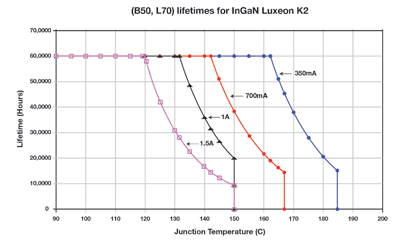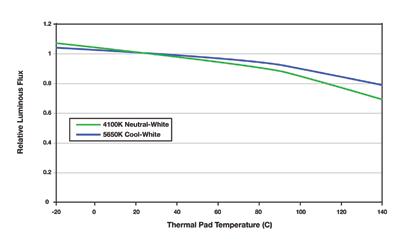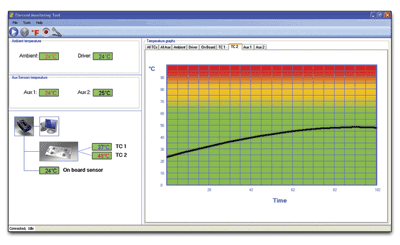Thermal engineering & test: The key to reliable SSL
Without proper thermal management, light output decreases, dominant wavelengths increase, and color temperature shifts
BY ROB RIX
Vice President, Lighting
TE Connectivity
www.nevalo.com
Unlike incandescent lighting that radiates heat, the heat generated by LEDs must be conducted away from these semiconductor devices. Without proper thermal management LED light output decreases, dominant and peak wavelengths increase and color temperature shifts. Addressing these thermal challenges is of critical importance in assuring the efficacy and life-expectancy of solid state lighting (SSL) fixtures.
Temperature effects
With the proper thermal design considerations, LEDs can last well over 50,000 hours (Fig. 1 ). However, in addition to reducing the operating life, increasing temperature reduces the performance of LEDs. Relative luminous flux (light output) is reduced as temperature increase. with increasing temperature (Fig. 2 ). For some LEDs, at a case temperature of 130°C, the output is reduced 80% or more depending on the color temperature rating.

Fig. 1: Increasing current requires lower junction temperatures to achieve extended operating life.

Fig. 2: The relative light output decreases with increasing thermal pad (case) temperature.
The critical LED temperature — the junction temperature—is deep within the package, far from the surface of the chip. Since this is not easily measured, a package (or case) temperature is normally read and the actual junction temperature is calculated. The maximum junction temperature, for some LEDs, can be up to 150°C and the normal operating case temperature is between -40 to 135°C. Each LED manufacturer determines the maximum junction temperature for their LEDs with the value growing on newly-introduced devices.
Measurements and management
In LED Luminaire Reliability published by the U.S. Department of Energy, the authors point out that LED luminaire life is not identical to estimated LED life. As a result, they stress the need to understand how temperature was measured and how it relates to the expected life of the system. Centrally located temperature sensors are not sufficient to monitor, detect and protect multiple LED designs.
The National Electrical Manufacturers Association standard NEMA LSD 45-2009, Recommendations for Solid State Lighting Sub-Assembly Interfaces for Luminaires, provides detailed recommendations for temperature test points for LEDs. With properly located temperature sensors, the temperature can be measured, monitored and controlled by additional circuitry. The added circuitry increases the complexity of the SSL design but it also adds to the performance, reliability and lifetime of the luminaire.
While thermal management is essential for the electronics portion of SSLs, thermal design is one of the key factors that impacts fixture aesthetics. The challenge for luminaire designers is making a piece of aluminum aesthetically pleasing. In combination, thermal management and heat sink provide the performance and long term reliability that make SSLs the ideal technology for energy-efficient lighting.
Thermal testing is an essential element in the design of a SSL fixture. Several questions related to thermal performance need to be satisfactorily answered, including:
Does the thermal design sufficiently assure the efficacy of the light source?
Is a heat sink required, or does the luminaire construction provide sufficient heat dissipation?
Does the thermal design account for worst-case conditions?
The answers to these questions require detailed thermal analysis and may require multiple iterations to optimize the final design. This can be quite time consuming, particularly if it is necessary to utilize outsourced testing services.
A system approach
With the complexity of making accurate temperature measurements combined with the desire to shorten time-to-market, specially-designed test tools that accurately record temperatures can simplify the task of verifying that the design has been done correctly.
An example of such an approach is a tool offered as part of the TE NEVALO system. The way the tool is used demonstrates how the key elements needed for thermal analysis can be integrated to satisfy user needs.
The thermal evaluation tool (Fig. 3 ) includes three components:
1. An LED Light Module (LLM) configured for thermal test. The module is identical to the production LLM, except that it includes a thermal test circuit (thermistors).
2. An interconnect for attachment to a thermal test instrument.
3. Test software with a graphical user Interface (GUI) that runs on a PC.

Fig. 3: A four-LED light module (a) and its thermal test board (b) counterpart. The special connector on the right-hand side of the test board provides connectivity to a PC through the USB port.
With such a tool, designers are able to confirm the thermal performance of each LLM in the actual lighting fixture. The tool thus can facilitate monitoring of the junction temperature of the LEDs under different operating and environmental conditions. In addition, the tool can assist in:
• Analyzing LLM design and correlating the design to the LED junction temperature;
• Optimizing LLM reliability testing; and
• Optimizing the size of the heat sink required for keeping the LED in safe operating temperature.
The tool records and log the LLM temperature on a GUI displayed on a PC screen in a format similar to that of chart recorders. Temperature readings can be made either in °C or °F with the accuracy of ±0.1°C. While the tool provides rather detailed information, it also has a simple Go/No Go indication of an acceptable thermal design. A stable temperature in the “green” zone indicates an acceptable thermal design, but being too far down in the green would suggest less need for heat sinking.

Fig. 4: The PC GUI display of thermal test tool data provides a record and log of the LLM temperature.
With the data obtained from the thermal evaluation tool, a complete SSL system can be tested and results documented, verifying that the system performs well within LED design specifications while also determining the safety factor in the fixture’s design.
As lighting manufacturers transition designs from conventional (incandescent) to solid state lighting, thermal design and performance add a new, and perhaps unfamiliar, layer of design complexity. Rigorous evaluation of thermal performance is essential to assure the efficacy and life-expectancy of SSL luminaires. ■
Advertisement
Learn more about TE Connectivity





